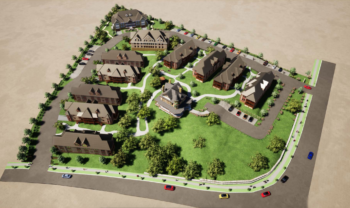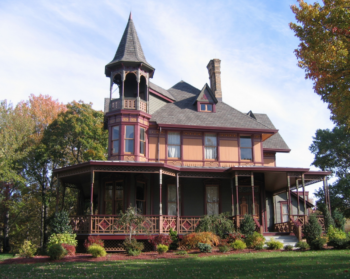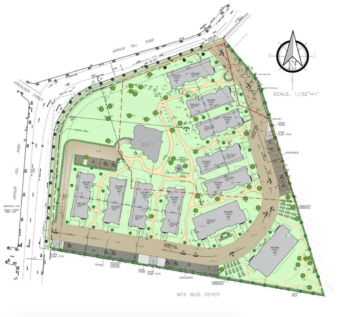
Rendering of new senior housing complex by landmarked Kreischer House./Image Credit: Victorio Associates Architects and LPC
Landmarks expressed support for the proposed senior housing complex but raised some concerns regarding the new buildings’ impact on the Kreischer House site. On February 4, 2020, the Landmarks Preservation Commission held a public hearing on a Certificate of Appropriateness for three actions to facilitate the development of a new senior housing complex, comprised of eleven buildings, surrounding the Kreischer House. The Kreischer House is located at 4500 Arthur Kill Road in Charlestown, Staten Island. The house and a portion of the land it sits on is landmarked. The project site, which is a total of 206,821 square feet of land, includes the Kreischer House and the landmarked site. The landmarked site, which is 81,102 square feet of land, is located on the northeast portion of the project site. The project site is on the east side of Arthur Kill Road between Englewood Avenue and Tiller Court. The MTA Charleston Bus Depot is located directly south of the project site and the Colonial Rifle and Pistol Club is located to the east of the project site.
To facilitate the development of the complex, the applicant is asking Landmarks to approve three actions. First, the applicant is asking Landmarks for permission to construct four of the eleven new buildings on the landmarked site. Second, the applicant is asking Landmarks for permission to install a handicap lift to the front of the Kreischer House. Third, the applicant is asking Landmarks to provide a report recommending that the City Planning Commission support the modification of use regulations on the project site from manufacturing use to residential use. The site is currently zoned as a light manufacturing district that does not allow residential use. When an applicant proposes to modify use regulations on a landmarked site, they must reach out to Landmarks for a report supporting this modification before filing for a special permit with City Planning.
The Kreischer House

Kreischer House/Image Credit: Victorio Associates Architects and LPC
The Kreischer House is a two and a half story mansion designed by Pallister and Pallister and built around 1885. A spokesperson for Landmarks told CityLand that they believed the Kreischer House was one of two twin mansions built for the sons of factory owner, Balthasar Kreischer. Kreischer was the founder of the New York Fire-Brick and Staten Island Clay Retort Works factory. Kreischer’s factory played a significant part in the industrial development of Staten Island. The success of the factory led to the development of the surrounding community which became known as Kresicherville, one of Staten Island’s earliest industrial centers. The mansion, which is the only remaining structure on the land, is a symbol for Balthasar Kreischer, Kresicherville, and the factory’s contributions to Staten Island. The house sits on a landscaped knoll surrounded by trees to the south and the east.
The Kreischer House is designed in the Stick-style, a Victorian-era architecture style. Prominent characteristics of the mansion include a gable roof with dormers, a balcony on the top floor with a projecting gable overhang, a porch roof that is supported on decorative posts, a veranda that partially surrounds the mansion, and an ornate porch railing with diamond-shaped panels set between vertical and horizontal members of wood. There is a three-story polygonal tower on the northwest corner of the mansion.
The Proposed Development

Proposed site plan for new senior housing complex./Image Credit: Victorio Associates Architects and LPC
The proposed senior housing complex will comprise of eleven new buildings along the south and east sides of the project site. Ten of the buildings will be in a U-shaped arrangement surrounding the Kreischer House. Five buildings will be built along the south side of the site and four buildings will be built on the east side of the side on the landmarked portion. The buildings on the south side will be at least 45 feet away from the Kreischer House and the buildings on the east side will be at least 69 feet away from the mansion. One building will be located behind the U-shaped arrangement. The buildings will be three-stories tall with a cellar level garage and will bring a total of 48 residential units for seniors.
According to the applicant, the new buildings’ architecture and design will relate to the Kreischer House. The buildings will have a brown gable roof with green dormer windows for the third floor. The buildings’ first and second-floor façades will be made from khaki-colored clapboard siding and the windows on the façades will have dark brown casings. The buildings’ balconies and porches will have decorative railings with diamond-shaped panels, similar to the railings of the Kreischer House. The buildings’ façades on the cellar level will be made from a medium brown colored brick veneer. There will be two garage doors on the cellar level of each building.
The applicant plans to pave one wide roadway on the project site to allow residents to drive into the complex. The roadway would be connected to four accessory parking lots on the site. There are two lots located on the south end of the site, one lot located on the east end of the site, and one lot located west of the Kreischer House. The applicant also plans to pave multiple walkways within the complex site to connect the eleven buildings with one another and connect them to the Kreischer House. The applicant will also incorporate some landscaping on the complex including planting trees in between the buildings.
The Kreischer House will also be restored as a part of the senior housing development. The house will be used as office space for the complex’s homeowner’s owners association and a drinking and eating establishment for residents. The applicant plans to repaint the mansion’s façade, repair and reinstall damaged decorative materials, reconstruct missing details such as window panels and the diamond-shaped railing panels, replace the mansion’s duct systems, remove plywood from the windows and install new glass, and install a new handicap lift.
Landmarks Public Hearing
At the February 4th hearing, the applicant stated the local community has expressed that they wanted senior residences on the land and noted that, in 2001, Landmarks had previously approved a single L-shaped four-story senior housing building with 126 apartment-style units. However, no construction was done and the project’s permit expired.
John Kilcullen, who testified on behalf of the Preservation League of Staten Island, stated that the League supports the project because it meets the community’s desire for senior housing and will allow for the Kreischer House to be restored. However, there is a concern that the parking lot by the Kreischer House takes away the mansion’s pastoral element. He also believes more trees should be planted as a screen between the project site and the MTA bus depot.
Kelly Carroll, who testified on behalf of the Historic Districts Council, stated that HDC is concerned about the proximity of the new buildings to the Kreischer House. She stated that HDC believes that the new buildings have a larger footprint than the Kreischer House and the buildings’ arrangement hides the mansion. HDC believes that the new buildings should be re-scaled.
The Commissioners also shared the concerns brought up in the public testimony including the landscaping of the grounds, the visibility of the Kreischer House in relation to the new buildings, and the placement of the parking lot by the Kreischer House. Commissioner Michael Goldblum suggested that the applicants should restore the landscape of the grounds after paving to include plantings, trees, and materials for the walkways. He also suggested that the applicant reduce the setbacks on the new buildings to create more visibility and distance between the Kreischer House and the new buildings.
Aside from the concerns, the Commissioners were generally in support of the new senior housing complex. Chair Carroll asked the applicants to modify the proposal based on the Commissioner’s comments and the testimony. She told the applicants to work on the location of the parking lot because it is very prominent, put in more thought into the distance between the new buildings and the Kreischer House, reduce the height of the new buildings, and integrate more landscaping features into the proposal.
By: May Vutrapongvatana (May is the CityLaw Fellow and New York Law School Graduate, Class of 2019).

